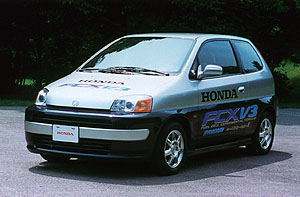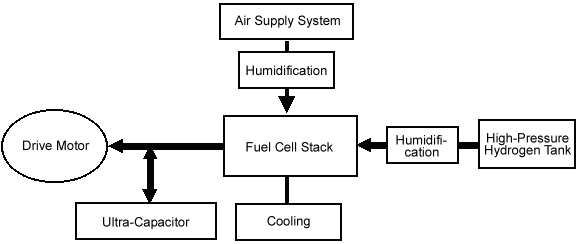Tokyo, July 4, 2001 --- Honda Motor Co., Ltd. announced today that it has received permission from Japan's Ministry of Transport to conduct fuel cell vehicle (FCV) testing on public roads. Testing of Honda's FCX-V3 vehicle will begin in mid-July on the freeways and surface roads in Tochigi Prefecture and other areas.
Honda has already conducted public road tests in the United States as part of the California Fuel Cell Partnership (CaFCP), a joint-participation project that includes the California and Federal government agencies, energy companies, auto manufacturers and fuel cell stack manufacturers. From the start-up of CaFCP's test program in November, 2000, through June of this year, Honda's fuel cell vehicles have logged more than 3,500 miles (approx. 5,600km) -- making steady progress in verifying the suitability of fuel cell vehicles for the American market.
Honda's public road tests to begin this month in Japan will be conducted over a wide variety of routes, including freeways and city streets, to study the suitability of fuel cell vehicles for the Japanese market under a variety of traffic conditions.
The FCX-V3 employs a smaller motor and fuel cell system (including control equipment) than earlier Honda models, creating enough room for four passengers. Other improvements, including better performance on startup and quieter operation, have also been added for greater product appeal. A Ballard fuel cell stack is used, fueled by pressurized hydrogen. The excellent continuous electric power generation of the fuel cell stack and the powerful, instantaneous discharge capabilities of an ultra-capacitor combine to achieve highly efficient energy management resulting in much-improved takeoff and acceleration performance. In the U.S., public road testing continues with an FCX-V3 equipped with a stack developed by Honda.
Honda has long held that the fuel cell will be the next-generation power plant needed to address challenges such as developing alternative fuels, reducing exhaust gas emissions, and reducing the effects of global warming. Honda will continue to accumulate data from road tests in the United States and Japan toward improving its basic fuel cell technology, with the objective of introducing a production fuel cell vehicle in 2003.

FCX-V3 Testing Fuel cell vehicle
on Japanese roads
<FCX-V3 System Layout (Conceptual)>

<FCX-V3 Specifications>
(Please note that this information is available in Japan only)
| Top | Speed | 130km/h |
| Motor | Max.output | 60kW (82PS) |
| Max.drive torque | 238Nm | |
| Fuel cell stack | Type | Ballard PEFC (solid high-polymer) |
| Output | 62kW | |
| Fuel | Type | Pressurized hydrogen gas |
| Storage method | High-pressure hydrogen tank (250 atmospheres) |
|
| Capacity | 100L | |
| Cruising distance | 180km | |
| Accommodating capacity | 4 people | |